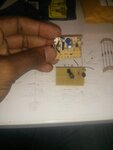TakingYouOHMs
Newbie level 3
Good morning everyone!
I'm new to building boards and have been working on small projects but I'm currently hitting a bit of a wall. I began building a board for a friend who has a sound Super 8mm sound projector. We were replacing the old board on the machine that he bought off Ebay. When the board came it was in terrible condition:

The picture is also missing the power connector that powers the LED externally and potentiometer that fell off the moment I picked it up. I feel a bit overwhelmed with this board, no schematic with it or anything, kinda got shafted but I know it's not impossible to create another. Is there anyone that could possibly give a few pointers or some small assistance, it would be great appreciated.
I'm new to building boards and have been working on small projects but I'm currently hitting a bit of a wall. I began building a board for a friend who has a sound Super 8mm sound projector. We were replacing the old board on the machine that he bought off Ebay. When the board came it was in terrible condition:

The picture is also missing the power connector that powers the LED externally and potentiometer that fell off the moment I picked it up. I feel a bit overwhelmed with this board, no schematic with it or anything, kinda got shafted but I know it's not impossible to create another. Is there anyone that could possibly give a few pointers or some small assistance, it would be great appreciated.